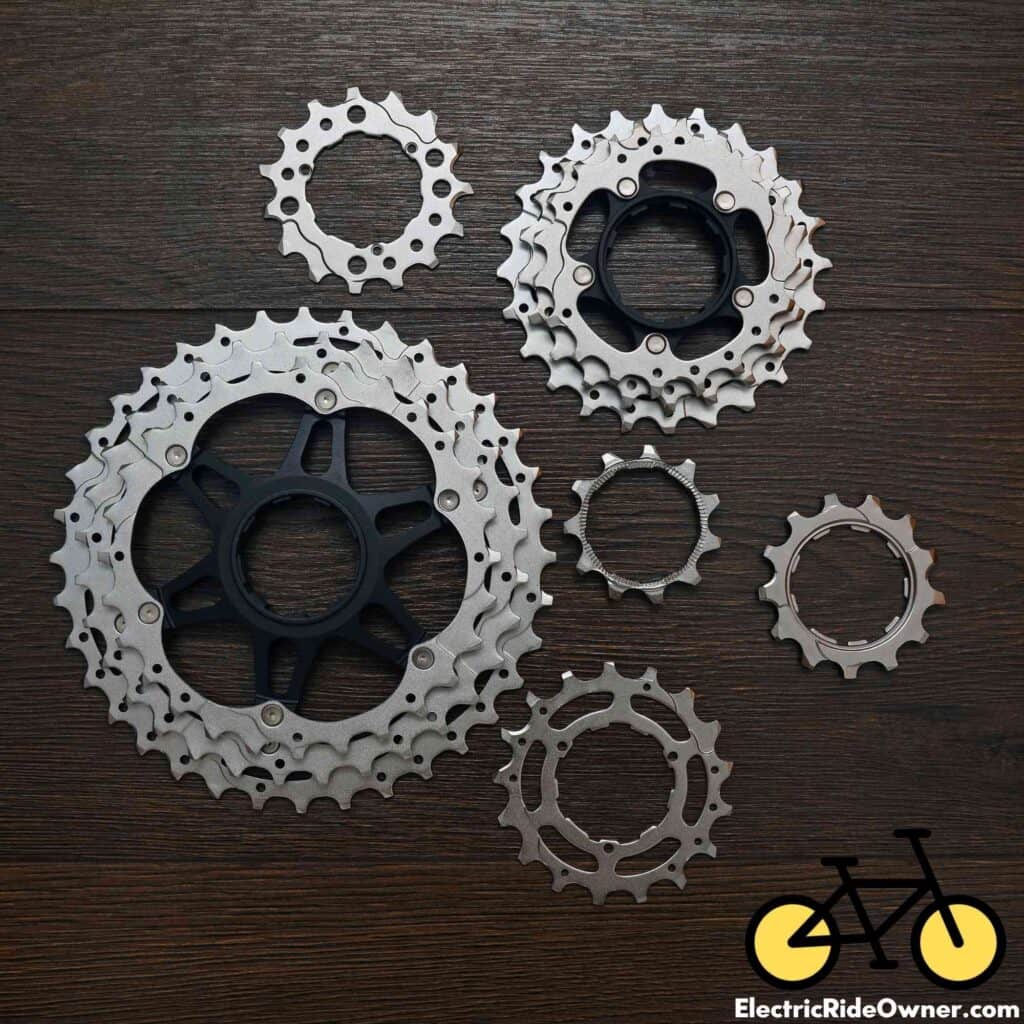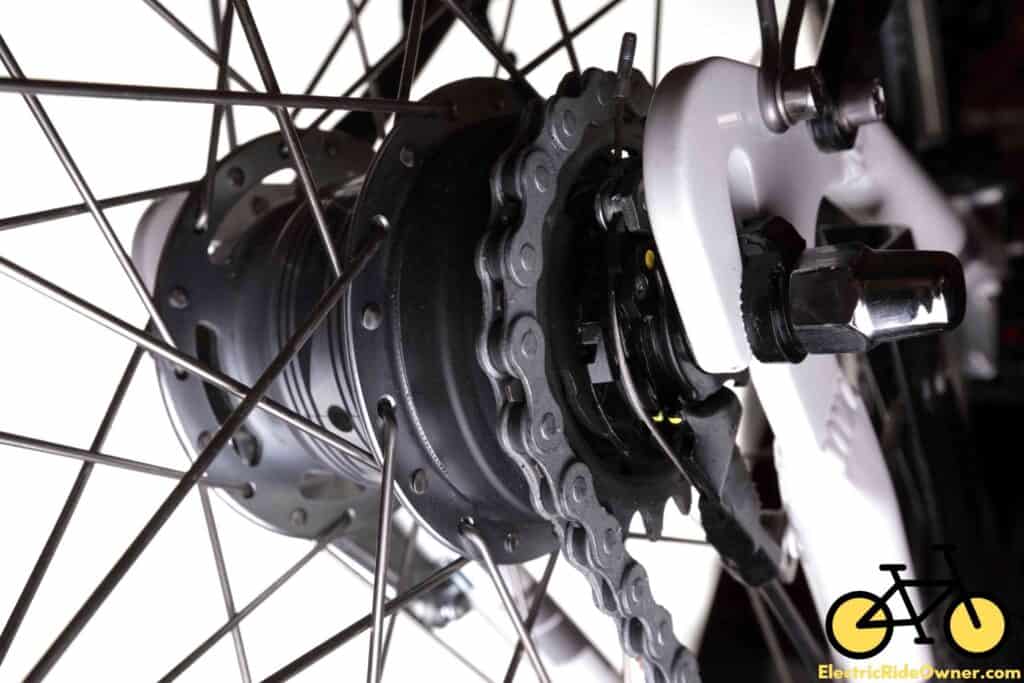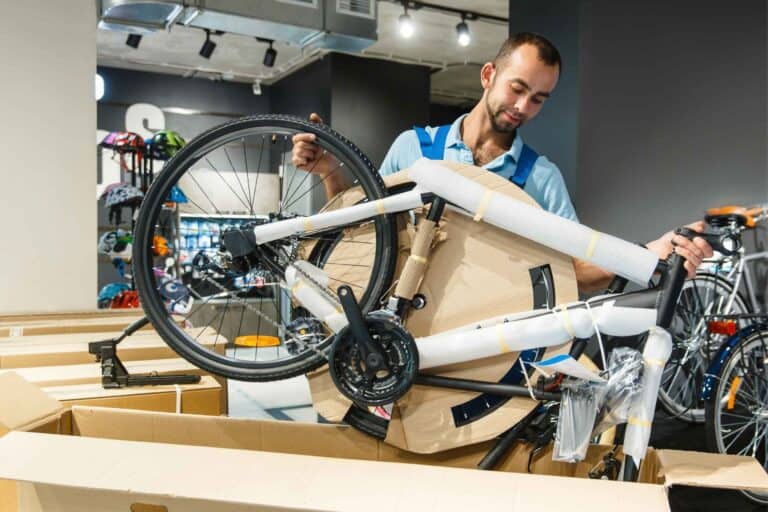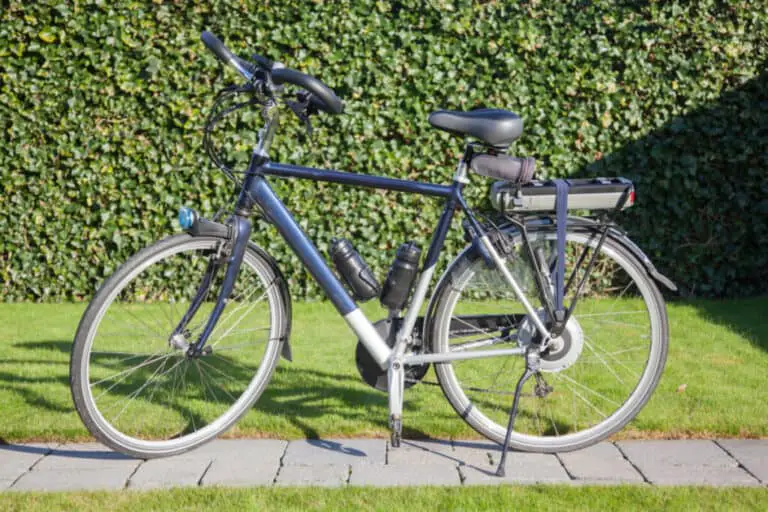Electric Bike Gears (Do You Need, How Many, How It Works)
There are many electric bikes on the market with gears and many without gears. When I bought my electric bike, I first wanted to understand the difference in the riding experience for electric bikes with gears and electric bikes without gears and which of the two best suited my riding needs. So, do you need gears on an electric bike?
On average, you do not need gears on an electric bike. Pedal-assist, powered by your eBike’s battery, is equipped to handle the various situations which would require a gear shift when using a standard bike. There are some extenuating circumstances.
Now you know you do not necessarily need gears on your electric bike, but you might be wondering why some riders prefer riding with gears rather than without. Keep reading to find out.
Do You Need Gears on an Electric Bike?
As a whole, you do not need gears on an electric bike. Pedal-assist intuitively identifies situations that would require a gear shift when riding a standard bike and assists the rider accordingly. However, some electric bikes are made with gears to improve the riding experience.
Pedal-assist for electric bikes is specifically designed to handle the situations in which shifting gears is needed when riding a standard bike. Electric bikes without gears, or single-speed electric bikes, know how much or how little to assist you when pedaling during your ride. So whether you’re riding up and down hills or trekking through rough terrain, rest assured most eBikes will get you to your destination no matter how treacherous the journey is.
Some riders, however, may prefer to have gears on their electric bike. Some reasons for this may include:
- Getting significant exercise
- Saving battery power
- To go faster on steep hills
Using Gears on Your Electric Bike to Get Significant Exercise
While you can get exercise on an electric bike that does not have gears by simply lowering the pedal-assist level, using gears on your electric bike can give you a much more effective workout.
When biking, you can elevate your heart rate higher by pedaling with greater resistance, so using an eBike that has gears at a higher gear level will require you to pedal harder, which will, in turn, raise your heart rate.
Check out our article on working out with an electric bike if you would like more information on getting a workout, losing weight, or maximizing your fitness using your electric bike.
Using Gears on Your eBike to Save Battery Power
When using your electric bike, you can move forward in one of three ways. You can either go fully automated (throttle), use pedal-assist, or pedal on your own. The throttle uses a lot of battery, and the pedal-assist (partially motored but assisted with your pedaling) uses some of your battery.
While pedal-assist is only partially powered by your eBike’s motor, it still uses battery life.
So, turning off pedal-assist and going fully manual or riding with low assistance at a higher gear can help preserve your battery life.
Some riders who have a long commute or use their eBikes for work may choose to lower their pedal-assist or pedal manually while using a gear shifter to preserve battery while traveling for long durations between access to a charger.
Check out our comprehensive article on electric bike batteries to learn about the nuances of electric bike batteries and how long they last.
Using Gears on Your Electric Bike to Go Faster on Steep Hills
While most electric bikes motors are equipped to handle steep hills, if you are riding in an area with an abundance of steep hills, it might be a good idea to get an electric bike that can shift gears.
When riding a standard bike, shifting gears is crucial when riding up and downhills. Like a traditional bike, shifting gears on an electric bike while traversing hills allows the rider more control over how fast the eBike goes on the hill and how much pedaling is necessary.
Most electric bikes have a top speed, so without the ability to shift gears, this top speed may be slower than desired when climbing a particularly steep hill. On average, it requires less effort to go fast when using a higher gear and more effort to go fast when using a lower gear.
When using gears on your electric bike, you can adjust how fast you want to go on a hill, and you can even go faster than the e-bike’s top speed might allow since its motor will not power you past a certain level. In addition, using gears may allow you to expend less effort to ride fast up and down hilly terrain.
Do Electric Bikes Have Gears?
As a whole, electric bikes do have gears. While some electric bikes on the market do not have gears, most electric bikes do have gears. Gears are not necessary on an electric bike, but many riders prefer the control gears provide during the riding experience.
The gear shifter on an electric bike is on the handlebars, not the motor. An electric bike motor does not power the gears, it only powers the throttle and the pedal-assist. The gears on an electric bike, the same as on a standard bike, are located in the rear of the bike.
An electric bike that does not have gears is called a single-speed electric bike. Riders who live in flat areas may prefer these eBikes over eBikes that have gears.
However, many electric bike riders prefer to have the option to use a gear shifter when riding their eBikes to give them more control over their rides and to give them a wider range of places they can ride their electric bikes.
Life is like riding a bike, you have to shift the gears, sometimes up and sometimes down, so that you reach the destination at correct pace and time.
—Sumeet Wadhwa
How Do Gears Work on an Electric Bike?
As a general rule, gears work the same way on an electric bike as on a standard bicycle; they control how much resistance you face when pedaling. There are two main types of gear systems on electric bikes: derailleur and hub gears.
While gears work similarly on an electric bike as on a standard bike, gears do not work the same way on every electric bike.
Let’s look at how gear shifters work for each way you can ride an electric bike.
| Is Gear Shifting Available? | Uses Battery? | |
| Single-Speed Electric Bike (Motor Turned On) | No | Yes |
| Electric Bike with Pedal Assist (Motor Turned On) | Yes | Yes |
| Electric Bike with Throttle Assist (Motor Turned On) | Yes | Yes |
| Any Electric Bike with Motor Turned OFF | Yes | No |
As you can see from the chart, there are pros and cons to riding an electric bike with gears while the motor is on vs. when it is off. When riding an electric bike and shifting the gears while the motor is on, you will be assisted in your ride, but you can only go as fast as the maximum speed on your electric bike without pedaling. Doing so may drain your battery.
However, shifting gears on your electric bike while the motor is off will allow you to go as fast as you can pedal without draining your battery.
Whenever you shift gears on your electric bike, whether it is with some help from the motor or completely manual, it is a good idea to shift to whatever gear you would if you were riding a standard bike, as this will help you save battery. It can be tempting to use a high gear when using pedal or throttle assist, but that is a sure way to drain your battery.
Derailleur Gear Systems

A derailleur gear system is located on the outside of the rear of your electric bike. Derailleur gear systems work like any other gear system on an electric bike or a standard bike. Because they are located on the outside of the e-bike and are exposed to the elements, they tend to wear quicker than gear systems that are contained in your eBike. While they are the most susceptible to damage, they are easy to clean or replace.
Electric bikes with derailleur gear systems tend to be more budget-friendly.
Hub Gear Systems
Hub gear systems or IGH (internal gear hubs) are fully encased in a covering located in the rear of your electric bike. The basics of a hub gear system are similar to any other gear system, except users can shift gears while stationary or shift several gears at once. You can do this with an IGH and not a derailleur system because you are not running the risk of having the chain come off the gear system, as you would with a derailleur gear system.
Hub gear systems are pretty low maintenance, as they are not exposed to the elements, and the risk of damage is low. However, if there is a problem, these systems are not usually user-friendly to repair, and a solution may require expert advice.
Electric bikes with hub gear systems tend to be more costly, as the IGH is more expensive than a derailleur gear system.

How Do You Use Gears on an Electric Bike?
As a general rule, to use gears on an electric bike, you click or spin the shifter on the handlebars up or down, depending on if you want a higher gear or a lower gear. Using gears on an electric bike will be similar or the same as using gears on a standard bike.
Shifting gears is a crucial part of riding your electric bike efficiently, but it can also be the most challenging part of learning how to ride your eBike. Learning how to shift correctly takes practice, but once you learn how to shift gears while you ride, it is as easy as, well, riding a bike.
Here are some key tips to remember when using gears on your electric bike:
- Shift one gear at a time
- If your bike has two shifters, remember:
- left = front gears
- right = rear gears (just remember right=rear!)
- When approaching a hill, keep in mind:
- high gear = more effort
- low gear = less effort (just remember low=less!)
Shift One Gear at a Time On An Electric Bike
When riding your electric bike and preparing to shift to gear more than two increments away from the one at which you are riding, remember to shift slowly, one gear at a time. You will need to pedal one complete revolution for your eBike to log your shift. Many riders recommend beginning this revolution when one of your feet is at the bottom of the pedal stroke, as this will be easier for you to keep track of.
If you shift your gears too fast, you can disconnect the chain from the gears. While this is an easy fix, it is also easily avoided. Most eBikes, and standard bikes for that matter, follow this rule, but it is essential to consult the handbook for your specific electric bike when learning how to operate it efficiently.
Left Gear Shifter vs. Right Gear Shifter
Some electric bikes will have one gear shifter, but some will have two. This depends on how many speeds you have on your bike. If your eBike has two shifters, the shifter on the left side will move the chainring to control the front gears. The shifter on the right side will move the cassette to control the rear gears.
If your eBike only has one shifter, it will likely be on the right side, and it will control gear shifting by moving the single chainring on your electric bike.
High Gear vs. Low gear
The purpose of shifting gears on an electric bike, much like a standard bike, is to maintain efficiency throughout your ride.
Riding in lower gears creates less resistance during your ride. Thus you may find yourself pedaling a lot with little movement. Lower gears are ideal for climbing a steep hill or getting moving from a stop. This is because a lower gear will help produce greater e-bike torque. If you want to learn more about electric bike torque feel free to check out this article.
Riding in higher gears creates more resistance during your ride. Thus you may find your pedaling will be slower. Conversely, pedaling at a slower speed will give you more control while going down a hill or riding at a higher speed.
How Do Electric Bike Shifters Work?
As a general rule, electric bike shifters work by controlling the electric assistance system and the gear shifting mechanisms. Typically, the left handlebar shifter will control the electric assistance system, and the right handlebar shifter will control the gear shifting mechanisms.

When handling the shifter on the left side of your handlebars, or the electric assistance system, you are controlling the level of pedal-assist at which you choose to ride your electric bike. Most electric bikes have 3 or 4 levels of pedal-assist. This shifter helps you control how much or how little motor assistance you would like during your ride.
When handling the shifter on the right side of your handlebars, or the gear shifting mechanism, you are shifting the gearing system of your electric bike. This shifter usually comes in a single speed (meaning there will be no gears to shift), three-speed, seven-speed, 10-speed, or 21-speed. This shifter helps you control how much resistance you feel when pedaling.
How Many Gears Do You Need on an Electric Bike?
On average, a single-speed gear system is sufficient on an electric bike. Electric bikes are equipped with electric assistance levels for any terrain, but some riders prefer gear systems with several speeds. The most popular gear systems for electric bikes come in three, seven, 10, and 21 speeds.
Riding an electric bike with multiple gears gives riders a wider range of control than riding an electric bike with a single-speed. Many riders prefer this more expansive range of control so they can turn off their motor during their ride or traverse terrain which requires more control over the bike’s speed, like steep hills.
Take a look at this table to find out what level of resistance you might feel while riding an electric bike with a several-speed gear system:
| Single-speed | 2-6 speed | 7-14 speed | 15-20 speed | 21+ speed | |
| Pedal-assist level: 0 (or manual) | No resistance, eBike goes as fast as you pedal | Low resistance, pedaling is easy | Medium resistance, pedaling is moderately difficult | High resistance, pedaling is difficult | Maximum resistance, pedaling is very difficult |
| Pedal-assist level: 1 | No resistance, eBike goes as fast as you pedal | Low resistance, pedaling is easy | Medium resistance, pealing is moderately difficult | High resistance, pedaling is difficult | High resistance, pedaling is difficult |
| Pedal-assist level: 2 | No resistance, eBike goes as fast as you pedal | Low resistance, pedaling is easy | Low resistance, pedaling is easy | Medium resistance, pedaling is moderately difficult | Medium resistance, pedaling is moderately difficult |
| Pedal-assist level: 3 | No resistance, eBike goes as fast as you pedal | Low resistance, pedaling is easy | Low resistance, pedaling is easy | Low resistance, pedaling is easy | Low resistance, pedaling is easy |
| Pedal-assist level: 4 | No resistance, eBike goes as fast as you pedal | Low resistance, pedaling is easy | Low resistance, pedaling is easy | Low resistance, pedaling is easy | Low resistance, pedaling is easy |
What Is the Best Gear Ratio for an eBike?
As a whole, there is no best gear ratio for an eBike. Different gear ratios allow the rider to experience different levels of speed and resistance. There are optimum gear ratios for specific scenarios, but there is not an overall best gear ratio for an eBike.
A gear ratio is a relationship between the chainring in the front to any of the gears in the rear. The gear ratio takes the number of teeth (or the spiky pieces on which the chain rests) on the chainring and divides that by the number of teeth on any of the gears located in the rear.
If your bike has seven gears in the rear, you will count the number of teeth on any of the seven gears, and that will be the number by which you divide the number of teeth on your chainring to get your gear ratio. So the gear ratio for each gear will be different.
The best gear ratio will depend on the environment in which you are biking. A lower gear ratio will create low resistance, making it easier to pedal. A higher gear ratio will create a high resistance, making pedaling harder.
Check out this video for more information about gear ratios on electric bikes:
Is a Higher Gear Ratio Harder to Pedal?
On average, a higher gear ratio is harder to pedal. Riding your electric bike in a higher gear ratio means you will face more resistance when pedaling, thus making it harder to pedal. When using a pedal-assist with a higher gear ratio, you may not find it difficult to pedal your eBike.
A higher gear ratio will be more challenging to pedal because you are pedaling in a higher gear, creating more resistance while you pedal. However, a higher gear ratio is ideal for gaining control in situations where you are riding at high speed. A higher gear ratio may also be suitable if you wish to get a significant workout when riding your electric bike.
What Is the Best Single Speed Gear Ratio?
As a general rule, the best single-speed gear ratio ranges from 2.5-3.0. This gear ratio does not make it too easy or too difficult to pedal, and it allows beginners to get a feel for their riding style and preferences.
The reason the best single-speed gear ratio ranges between 2.5-3.0 is that:
- It is ideal for cruising
- It is suitable for both uphill and downhill
- It is relatively easy for experimenting with different terrain
Ideal for Cruising
A single-speed ratio for your electric bike between 2.5-3.0 is excellent for beginners who plan to do most of their riding at a cruising speed in flat areas. This gear ratio will give you some resistance, but not too much, thus making it easy to maintain the speed on your electric bike.
Good for Both Uphill and Downhill Riding
A single-speed ratio for your electric bike between 2.5-3.0 is just enough resistance to have control while going downhill, while not being too resistant when climbing uphill. This gear ratio is not ideal if your regular terrain is very hilly but will be appropriate for the odd hill or two during your ride.
Easy for Experimenting with Terrain
A single-speed ratio for your electric bike between 2.5-30 is an easy ratio for any terrain in which you find yourself. While it is ideal for flat terrains, like a road or a flat dirt path, it will offer you just enough resistance to experiment with terrains outside of your normal paths.
Suppose you are planning to buy an electric bike. You might be interested to learn about the best electric bike brands you can choose from. Hence, you can check our article, “Best Electric Bike Brands (Ranked By Budget Level & Style” for insider secrets on the best electric bikes on the market.





